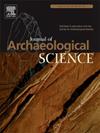消失的黄油技术:在黎凡特南部的晚铜器时代,一种可能的替代蜂蜡的方法,用于建造复杂的铸铜模具
IF 2.5
1区 地球科学
Q1 ANTHROPOLOGY
引用次数: 0
摘要
随着新社会制度的出现、其他工艺和技术的快速发展以及二次产品的引入,晚期的铜石器冶金术在黎凡特南部得到了发展。虽然铜制品遍布黎凡特南部,但大多数铜制品是在内盖夫、朱迪亚沙漠和约旦河谷发现的,体现了两种技术:将费南或提姆纳的纯铜铸造在开放式模具中,以生产简单的物品(如斧头、凿子和锥子);将非本地的多金属合金铜铸造在封闭式模具中,以生产相对复杂的物品(如砍头、标准、容器和王冠)。后一种技术通常被称为“失蜡技术”,人们普遍认为,晚期铜石器时代的工匠使用蜂蜡来制造模具。然而,虽然可能使用了蜂蜡,但我们也应该考虑其他可能性。我们认为灰黄油很可能起到了这个作用。与蜂蜡不同,在晚期铜器时代,黄油是一种日常生活中可以获得的物质,我们通过一系列的实验证明,通过将黄油与水和火木灰混合,晚期铜器时代的工匠可以生产出一种廉价而可用的材料,非常适合制作复杂的模具。本文章由计算机程序翻译,如有差异,请以英文原文为准。
The lost-butter technique: A possible alternative to beeswax for constructing complex copper-casting moulds in the Late Chalcolithic period of the southern Levant
Late Chalcolithic metallurgy developed in the southern Levant alongside the emergence of new social institutions, the rapid growth of other crafts and technologies, and the introduction of secondary products. While found throughout the southern Levant, most copper items were recovered in the Negev, the Judean Desert, and the Jordan Valley, manifesting two technologies: The casting of pure copper from Feinan or Timmna in open moulds to produce simple objects (e.g. axes, chisels, and awls) and the casting of non-local, polymetallic alloyed copper in closed moulds to produce relatively complex objects (e.g., maceheads, standards, vessels, and crowns). The latter technology is often dubbed the lost-wax technique, and Late Chalcolithic artisans are widely assumed to have used beeswax to construct the moulds. However, while beeswax might have been used, we should also consider other possibilities. We suggest that ash butter is likely to have served this purpose. Unlike beeswax, butter was an everyday, accessible substance during the Late Chalcolithic period, and we demonstrate through a series of experiments that by mixing it with water and fire wood ash, the Late Chalcolithic artisans could produce a cheap and available material highly suitable for making the complex moulds.
求助全文
通过发布文献求助,成功后即可免费获取论文全文。
去求助
来源期刊

Journal of Archaeological Science
地学-地球科学综合
CiteScore
6.10
自引率
7.10%
发文量
112
审稿时长
49 days
期刊介绍:
The Journal of Archaeological Science is aimed at archaeologists and scientists with particular interests in advancing the development and application of scientific techniques and methodologies to all areas of archaeology. This established monthly journal publishes focus articles, original research papers and major review articles, of wide archaeological significance. The journal provides an international forum for archaeologists and scientists from widely different scientific backgrounds who share a common interest in developing and applying scientific methods to inform major debates through improving the quality and reliability of scientific information derived from archaeological research.
 求助内容:
求助内容: 应助结果提醒方式:
应助结果提醒方式:


